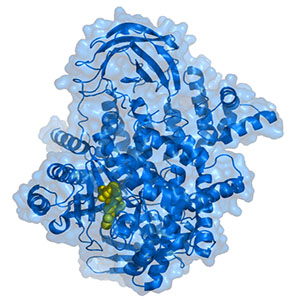SABCS 2016: The Search for an Effective and Safe PI3K-Inhibitor
Results from the phase III clinical trial BELLE-3, presented at the San Antonio Breast Cancer Symposium on Dec. 8, showed that the phosphoinositide 3-kinase (PI3K) inhibitor buparlisib was effective in patients with pretreated HR-positive breast cancer, but side effects are troubling.
Women with HR-positive breast cancer are treated primarily with endocrine therapies such as tamoxifen and aromatase inhibitors. Many patients, however, relapse when their cancers develop resistance to these therapies, despite initially responding.
Prior studies have shown that activation of a cell-signaling pathway called the PI3K/mTOR pathway, driven in some cases by a mutation in the gene PIK3CA, plays a major role in promoting resistance to endocrine therapies such as aromatase inhibitors. Inhibition of the PI3K/mTOR pathway is, therefore, considered a promising strategy to tackle resistance.
Clinical Trials Testing Buparlisib
Data gathered last year from the clinical trial BELLE-2 showed that, among women with locally advanced or metastatic HR-positive breast cancer resistant to hormone therapy, those who had tumors with mutated PIK3CA benefited from a combination of the PI3K inhibitor buparlisib and fulvestrant (Faslodex).
Many patients whose cancers have developed resistance to letrozole or anastrozole go on to take the mTOR-inhibitor everolimus along with exemestane (Aromasin), but some develop resistance to everolimus as well. In the latest study, BELLE-3, the investigators assessed whether the addition of buparlisib to fulvestrant is safe and effective in treating patients with HR-positive, hormone therapy-resistant breast cancer that was HER2-negative and had progressed on or after treatment with everolimus.
In this trial, investigators randomly assigned 432 patients whose HR-positive, HER2-negative breast cancers had progressed on everolimus to either a combination of daily buparlisib plus fulvestrant or placebo plus fulvestrant.
“For the first time, we have evidence from a phase III clinical trial that a PI3K inhibitor is a viable treatment option in combination with endocrine therapy for HR-positive advanced breast cancer patients progressing on everolimus plus exemestane,” says Angelo Di Leo, MD, lead author of the study and an oncologist from Ospedale Misericordia e Dolce in Prato, Italy.
The median progression-free survival (PFS) in the buparlisib/fulvestrant arm was 3.9 months, versus 1.8 months for those in the fulvestrant only arm, and the six-month PFS rates were 30.6 percent versus 20.1 percent, respectively.
The investigators also collected liquid biopsies (blood samples) from these patients and studied the status of PIK3CA in their circulating tumor DNA. Data on PIK3CA status was available for 349 patients. Among the 147 patients who had PIK3CA mutations, PFS was 4.7 months for those in the buparlisib/fulvestrant arm, versus 1.6 months for those in the fulvestrant only arm.
“Testing for PIK3CA mutations seems to be relevant because buparlisib does not seem to have relevant activity in the absence of the mutation,” Di Leo says.
Further analysis showed that a subgroup of patients who previously did not benefit from a combination of endocrine therapy and an mTOR inhibitor had the most benefit from fulvestrant plus buparlisib, leading the investigators to speculate that PI3K inhibitors may work best for patients whose cancers are resistant to mTOR inhibitors.
New PI3K Inhibitors With Better Safety Profiles Are Needed
Given that an earlier PI3K inhibitor, pictilisib, tested in combination with fulvestrant in a phase II clinical trial did not show much promise for women with HR-positive, aromatase inhibitor-resistant advanced breast cancer, it is noteworthy that buparlisib did seem to keep cancer from progressing in this patient population for a longer period of time, particularly among those whose tumors had PIK3CA mutations and those who were treated with mTOR inhibitors previously.
The side effects from buparlisib treatment, however, are concerning.
Patients in the buparlisib arm experienced many adverse events, including a rise in liver enzymes (indicating liver damage) and psychiatric symptoms such as anxiety, depression, and thoughts of suicide.
These side effects may lead to deterioration in patients’ quality of life and may be responsible for temporary or permanent treatment discontinuations, Di Leo says. “Considering all this, I believe that we need further research in the attempt to identify new PI3K inhibitors with a comparable level of activity and with a better safety profile,” adds Di Leo.
Anxious for Another Big Win
Symposium attendee Teri Pollastro, a mother of two daughters and a patient advocate who has lived with metastatic breast cancer for 13 years, says she is discouraged to hear about the side effects of buparlisib.
“We haven’t seen great results in a long time since Herceptin,” she says, referring to the high number of side effects from both newer molecularly targeted therapies as well as hormonal therapies. Although there have been some advances against metastatic breast cancer, she hopes to see more options that could improve survival without affecting quality of life. “I don’t know when my luck will wear off, and I am not done yet,” says Pollastro.
“We are ready for another big win,” she adds. “It’s time.”





